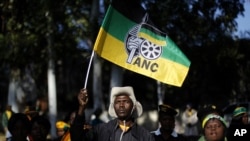JOHANNESBURG, South Africa - A painting that depicts South African President Jacob Zuma with exposed genitals has been removed from a Johannesburg gallery and two local websites, following an outcry led by the ruling African National Congress party that ended in a protest at the gallery Tuesday. The controversy has sharply illustrated the deep divisions that remain in South African society.
ANC Secretary-General Gwede Mantashe made it clear to protesters outside the Goodman Gallery, and to the country, that what his party wants, they can often get.
“Your power has removed that painting from the website of City Press and from the gallery," said Mantashe. "It has forced an apology from both the Goodman Gallery and Brett Murray, it has forced an apology from the City Press. That is your power.”
The painting of Zuma was one of an exhibition at the gallery that depicted the South African leader and his party as greedy, self-obsessed, and deaf to the needs of the people who voted them into power. It went largely unnoticed until a reporter asked for ANC comment on an article about the exhibition in the City Press newspaper, which also displayed a photograph of the painting on its website.
The ANC unsuccessfully sought a court order to have the painting removed from the gallery. Now Mantashe says it is the power of the people and not the courts that are the final arbiter.
“Basically we went to court, to say to the court, interdict City Press, interdict Goodman Gallery, they have not been interdicted by the court, they have been interdicted by you," said Mantache. "So it is your power that has interdicted these two institutions, therefore it is the power of the people that will shape and direct this country into the future.”
The controversy has once again highlighted the deep divisions that remain within South African society. Many black South Africans saw the painting as racist and an assault on unhealed wounds of apartheid.
City Press editor Ferial Haffajee withdrew the image from the paper’s website this week, writing that she did so because of the pain it has caused and because of fear. She was the subject of a torrent of invective and even abuse on social media platforms and in her community.
Zuma’s lawyer broke down while trying to convince the court of his argument, prompting a deeply moving article by highly regarded commentator Justice Malala.
He wrote that even though he supported the right of the gallery and the artist to display and create works of art, the outcry about the painting had compelled him to remember the pain, anger and even hatred in the recesses of his own heart and in those of his fellow black citizens, about the country’s past. Malala wrote it forced him to remember apartheid.
It is a pain reflected in a song that was sung at Tuesday's protest by Blade Ndzimande, minister of higher education. The song remembers that during apartheid blacks were prevented from aspiring to anything more than the most menial jobs, cooking in white kitchens, and mowing white lawns.
ANC Secretary-General Gwede Mantashe made it clear to protesters outside the Goodman Gallery, and to the country, that what his party wants, they can often get.
“Your power has removed that painting from the website of City Press and from the gallery," said Mantashe. "It has forced an apology from both the Goodman Gallery and Brett Murray, it has forced an apology from the City Press. That is your power.”
The painting of Zuma was one of an exhibition at the gallery that depicted the South African leader and his party as greedy, self-obsessed, and deaf to the needs of the people who voted them into power. It went largely unnoticed until a reporter asked for ANC comment on an article about the exhibition in the City Press newspaper, which also displayed a photograph of the painting on its website.
The ANC unsuccessfully sought a court order to have the painting removed from the gallery. Now Mantashe says it is the power of the people and not the courts that are the final arbiter.
“Basically we went to court, to say to the court, interdict City Press, interdict Goodman Gallery, they have not been interdicted by the court, they have been interdicted by you," said Mantache. "So it is your power that has interdicted these two institutions, therefore it is the power of the people that will shape and direct this country into the future.”
The controversy has once again highlighted the deep divisions that remain within South African society. Many black South Africans saw the painting as racist and an assault on unhealed wounds of apartheid.
City Press editor Ferial Haffajee withdrew the image from the paper’s website this week, writing that she did so because of the pain it has caused and because of fear. She was the subject of a torrent of invective and even abuse on social media platforms and in her community.
Zuma’s lawyer broke down while trying to convince the court of his argument, prompting a deeply moving article by highly regarded commentator Justice Malala.
He wrote that even though he supported the right of the gallery and the artist to display and create works of art, the outcry about the painting had compelled him to remember the pain, anger and even hatred in the recesses of his own heart and in those of his fellow black citizens, about the country’s past. Malala wrote it forced him to remember apartheid.
It is a pain reflected in a song that was sung at Tuesday's protest by Blade Ndzimande, minister of higher education. The song remembers that during apartheid blacks were prevented from aspiring to anything more than the most menial jobs, cooking in white kitchens, and mowing white lawns.








